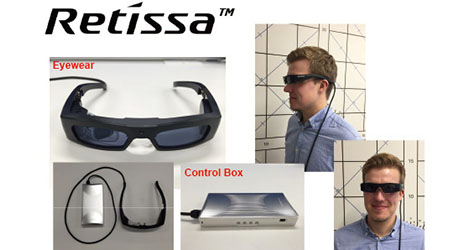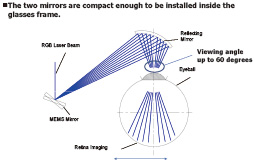Home > Highlighting JAPAN >Highlighting Japan June 2016>Science & Technology
Highlighting JAPAN


Laser Specs
Optical device venture QD Laser, Inc. has developed lightweight wearable glasses that can return the power of vision to sight-impaired people.
QD Laser is a semiconductor laser venture that was established in 2006. The company name “QD” comes from Quantum Dot, which is a nanometer-size semiconductor particle that was jointly developed by Fujitsu and Yasuhiko Arakawa, a professor at the University of Tokyo. High-efficiency semiconductor lasers, such as the quantum dot laser developed by QD Laser, are being utilized in a wide variety of fields, including optical communications, material processing, sensors, measuring devices and displays.
Working together with Professor Arakawa, QD Laser has applied all of the laser technology it has built up over the years to create a product in a completely untraditional area: retinal imaging laser eyewear (“laser wear”) — glasses for the visually impaired.
“We began developing laser eyewear in 2012, hoping to create new forms of value and markets through the use of our technology,” says Mitsuru Sugawara, president of QD Laser. “Laser eyewear can dramatically improve the quality of life of the visually impaired, in particular people with low vision.”
Low vision is a condition in which eyesight deteriorates because of a disease or injury and cannot be adequately corrected by glasses. Although some can read when using a magnifying glass, low vision is considered to be a major handicap in everyday life and work. The World Health Organization (WHO) defines low vision as a visual acuity of less than 0.3 (6/19) but equal to or better than 0.05 (6/120) when wearing corrective glasses. It is reported that there are 1.45 million people in Japan and 2.9 million people in the United States with low vision. Around the world, there are tens of millions of people with low vision.
The basic mechanism of laser eyewear is as follows: an image is taken with the camera attached to the front of the glasses and is projected on the retina at the back of the eyeball with an ultra-small laser. The technology to project a laser on the retina was developed in the United States in the early 1990s and was commercialized in the early 2000s. However, it did not become widespread due to the very large size of the glasses.
On the other hand, laser eyewear is used by connecting a controller weighing 300 grams to glasses weighing 50 grams with a cable. The glasses are nearly the same size as commonly used sunglasses. The laser technology and optical technique originally developed by QD Laser has made it possible to shrink the size and improve the performance. Since laser eyewear directly projects an image on the retina with a laser, it allows the user to see things without depending on the cornea or crystalline lens function for focusing which are normally needed to see things. This means that even if there is something wrong with the crystalline lens or the cornea, it is possible to see clear images as long as the user has a normal retina and optic nerve. If there is an abnormality on a specific part of the retina, such as age-related macular degeneration, all that needs to be done is to project a laser on the normal part of the retina. The laser is weak and does not damage the retina, even after directly projecting the images for hours.
Clinical studies are currently underway in Japan and Germany, and the efficacy of laser eyewear has been demonstrated. For example, in a clinical study performed at Essen University Hospital in Germany, a young man whose vision in both eyes had deteriorated to 0.028 (6/220) as a result of an accident put on laser eyewear and experienced a dramatic improvement in his vision. Laser eyewear brought his vision back to the 0.25 (6/24) level, at which reading became possible.
“We have presented laser eyewear at exhibitions in Japan, the United States and Europe, where we received a great response,” says Sugawara. “We have been delighted to hear the joyous feedback from people saying that laser eyewear has enabled them to see things clearly for the first time in their lives.”
The laser eyewear controller can also be connected to other digital devices. When connected to a smartphone, the actual images and information on the smartphone clearly appear right in front the user’s eyes.
Laser eyewear is scheduled to be marketed in Japan, Europe and the United States by the end of next year as Retissa. The initial price is expected to be around 500,000 yen.
QD Laser will continue working to improve laser eyewear. The main aspect that needs to be improved is its size, and QD Laser will strive to make the technology even more compact. The company also aims to reduce the electricity consumption from the current level of 1,000 mW to 80 mW by 2018. If this can be achieved, it will become possible to control the device through the glasses alone, without needing to connect it to a controller and cable. The key here is the laser.
“Advances in lasers will lead to further improvements in laser eyewear,” says Sugawara. “In the future, we will try to utilize our technology to enhance people’s vision in other ways, such as by enabling them to see over greater distances or even to see things in the dark.”
© 2009 Cabinet Office, Government of Japan







